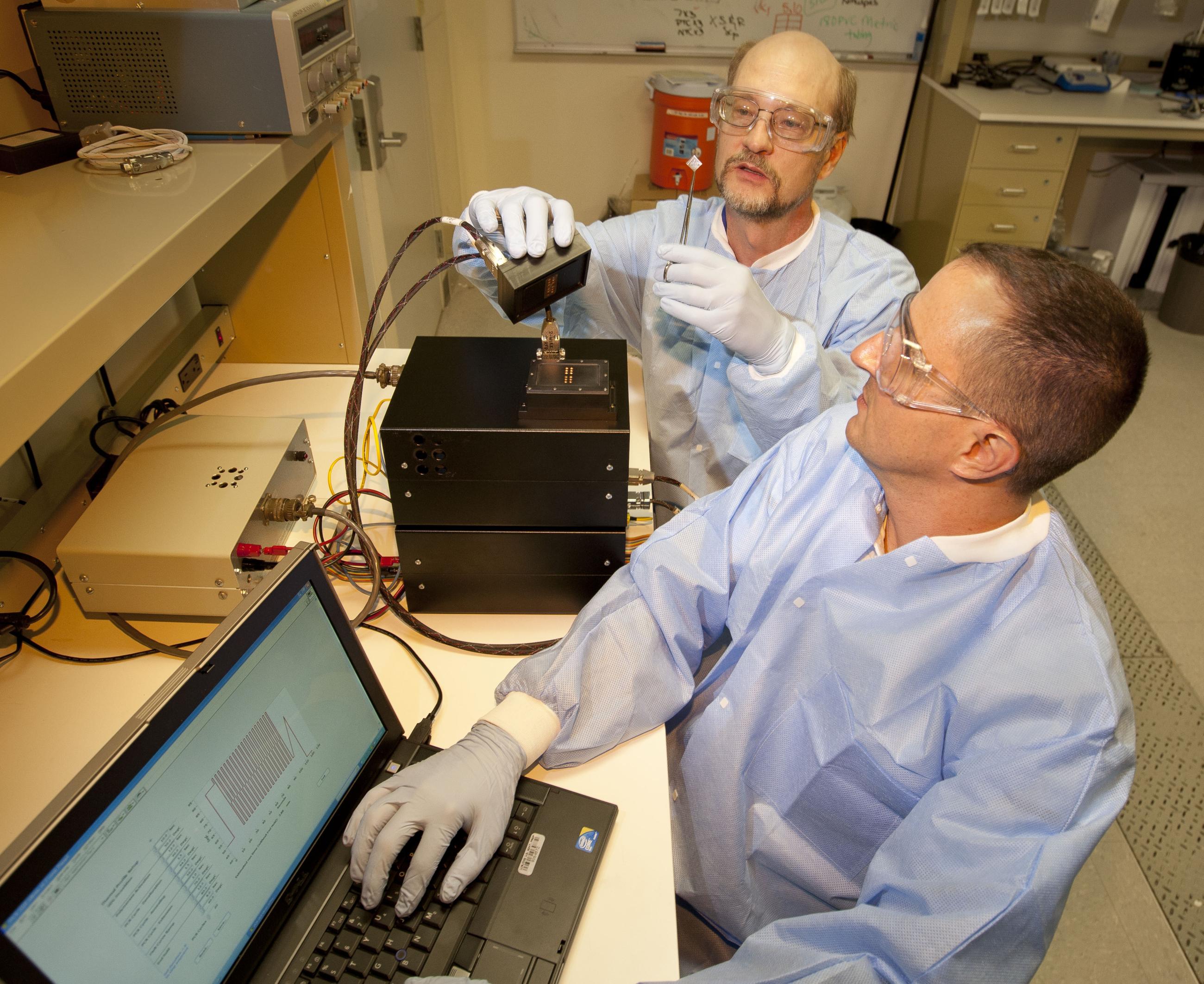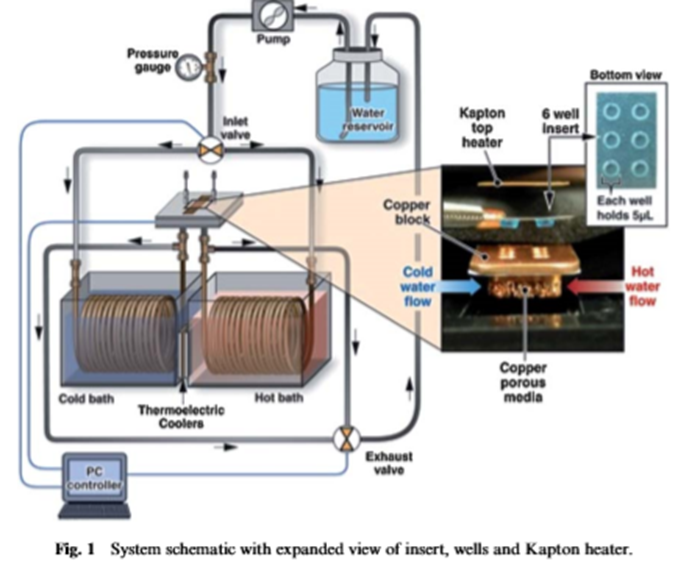Since its inception over 35 years ago, Polymerase Chain Reaction (PCR) has impacted every aspect of life science research. This method allows researchers to make many millions of copies of specific segments of DNA that can be further analyzed for medical and biological purposes. This process is temperature sensitive and good thermal management controls are required to successfully amplify the DNA. Current PCR methods lack rapid and uniform changes in temperature which can affect sample quality and integrity. Technologies in this portfolio address the need for faster PCR methods with precise thermal controls.
Solid-state distributed node-based rapid thermal cycler for extremely fast nucleic acid amplification (LLNL Internal Case # IL-12275, US Patent 8,720,209)
Researchers at Lawrence Livermore National Laboratory have developed a new method for faster, more accurate, and precise thermal control for DNA amplification. This technology uses sensor-controlled nodes to monitor and cycle materials through a microfluidic heat exchanging system. Thermal energy travels from a power module through thermal electric elements to sample wells. Sensors coupled to each sample well monitor and respond to predetermined temperature thresholds allowing for the simultaneous directional transfer of thermal energy and therefore better thermal cycling controls.
When using LLNL’s solid-state distributed node-based rapid thermal cycler, researchers can be assured that sample DNA is being amplified under optimal conditions. The constant communication between sensors and controllers within the system increases the efficiency of this apparatus’ thermoelectric elements resulting in higher quality samples for better data integrity in a shorter amount of time. The figure illustrates a top view of a solid-state heat exchanger in a thermal cycling system with a thermoelectric element for each heat exchanger well pair.
Methods and compositions for rapid thermal cycling (LLNL Internal Case # IL-12328, US Patents 9,170,028; 9,939,170)
This embodiment of PCR technology incorporates the use of microfluidic thermal heat exchanger systems and is comprised of a porous internal medium, with two outlet channels, two tanks, and one or more exchanger wells for sample receiving. The wells and their corresponding inlet channels are coupled to two tanks that contain fluid with cold and hot temperatures. A controller is used to dictate the position of the fluid pump’s valves, which directs fluid flow between tanks. The fluid passes though the system’s porous medium, heating or cooling the samples being housed in the wells. When the fluid passes through the matrix, it provides extremely fast heat conduction that enables rapid thermal transfer between the fluid, matrix, and sampler holder. This technique has considerably higher heating/cooling temperatures ramps and it can produce very uniform temperatures utilizing lower input power than prior equipment. By keeping samples at optimal temperatures, researchers can expect a higher sample throughput and better quality, resulting in more reliable data.
Another embodiment of this apparatus allows the microfluidic heat exchanger to directly receive a sample tray. This sample tray may include one or more sample wells and may be configured to align with the microfluidic heat exchanger. Therefore, allowing the aligned wells to be inserted into the microfluid heat exchanger. The heat exchanger may be an electrical heater in the form of a surface or internal heater and is designed to supplement the heating of samples resulting from fluid flowing through the apparatus’ internal porous medium. This technology would eliminate the need for a hot tank. The figure shows a microfluidic heat exchanger in a thermal cycling system which incorporates a microfluidic heat exchanger, two tanks, a valve, a pump, a reservoir, and a switching controller.
Rapid microfluidic thermal cycler for nucleic acid amplification (LLNL Internal Case # IL-11903, US Patent 9,170,060)
LLNL scientists have developed a new device that provides a unique method for extremely fast DNA amplification. This device utilizes lower input power and can produce higher temperature ramp due to the innovative heat transfer characteristics and the integration of a microfluidic platform. The system is composed of microfluidic heat exchangers, porous media within the heat exchanger, and controllers that dictate the flow of the cold and hot fluid throughout the microfluidic system. The use of controllers to monitor and dictate the directional flow of fluids provides greater overall flow through the system. The heat exchanger utilizes pressurized flow from the cold and hot reservoirs to maintain the ideal PCR denaturing and annealing temperatures. The speed and thermal precision of this device presents the possibility for near-instantaneous and specific DNA based diagnostics. Researchers have reported that this method of rapid heat transfer can complete 30 cycles of PCR amplification in as little as three minutes. This novel method for microfluidic PCR sample analysis is extremely fast. The figure shows a microfluidic heat exchanger in a thermal cycling system.
Integrated solid-state rapid thermal cycling system (LLNL Internal Case # IL-12840, US Patent Application 2020/0047184)
LLNL researchers have designed a new technology that allows the integration of a large bench-top thermal cycling instrument onto a miniaturized instrument. This instrument is powered and controlled by portable thumb-drive systems such as an USB. USB thumb-drives are commonly used to transfer data from the instrument onto a PC, however, in this new technology the thumb drive becomes the instrument itself. LLNL researcher’s technology includes thermocycling configured for low power and efficiency, miniaturization of components and controllers, fabrication on a solid-state thumb drive, and integration with USB data and supplied power. This system uses bus power for thermal cycling and bus data lines for data transmission and programming, which allows for portable power. The system can handle 4 wells of 5uL volume cycling with 5 seconds ramp time which is high performance by compassion to benchtop cycles. Additional wells can also be added. The integration of a thermocycle onto a programmable device allows for a portable power, faster and better use friendly software and the thumb drive can be used on the user’s PC. The figure shows (A) conceptual assembly of the technology and (B) description of the technology.
- Genotyping, Cloning & Other Applied Research
- Rapid & Specific Infectious Disease Diagnosis
- Forensics
- Medical & Clinical Diagnostics
- Food Pathogen Detection
- Agricultural Biotechnology




